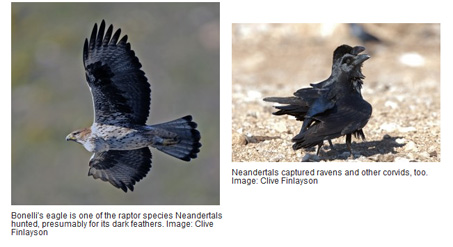Cave Couture
The next time you’re adjusting your fascinator to attend Cousin Trudie’s wedding, you may think, why am I doing this? Not in the sense of why am I supporting this wedding which I know is a sham because he’s intellectually inferior to her, he’s a cat person and he’s a Scorpio, so it’ll never work…but more in terms of why the urge to pin feathers to your hair? Well, according to recent studies, you are responding to an ancient urge for feather adornment that goes back as far as Neandertal civilization.
A recent article in Scientific American magazine described how new evidence suggests that Neadertals used bird feathers as adornment. This flies in the face of previous theories that Neanderthals were not advanced enough to exploit smaller prey, such as birds, and that they did not yet express themselves through symbolic behaviours. Such shortcomings, according to previous theories, put Neandertals at a disadvantage when more modern humans with more skills invaded Europe.
Paleontologist Clive Finlayson and zooarchaeologist Jordi Rosell and colleagues recently reported their analyses of animal remains at 1,699 fossil sites in Eurasia and North Africa spanning the Pleistocene epoch. Their findings indicate that Neandertals were strongly associated with corvids (ravens and the like) and raptors (eagles and their relatives).
The evidence gathered from these bird remains suggests that they were not eaten for food (people do not eat corvids or raptors today), but that the beautiful flight feathers were used as adornment. Further, cut marks were found on wing bones—not the meatiest part of the bird. Additionally, according to archaeologist John Shea, the Neandertals’ preference for dark-feathered birds mirrors their preference for black manganese pigment, which is known from a few sites. Finlayson believes the Neadertals may have used flint tools to separate the plumage from the wing bones still attached to the skin to create a kind of cape or headpiece.
Though Neandertals may not have had the most sophisticated tools, Rosell points out that many of these birds would have been easy to capture by hand. Vultures, for example, often hang out in tree branches waiting for a current to carry them. Gibraltar—where many cutmarked bones have been discovered– is on a major migratory route for many species, and the birds often arrive tired from the shifting winds and easier to catch.
Previous findings of cut bird bones from Neandertal levels in Fumane Cave in northern Italy were dismissed as an isolated event. But Finlayson and Rosell’s study indicates that feathers were almost definitely a kind of fashion statement for thousands of years, possibly across Eurasia, and indicative of a certain level of sophisticated, symbolic behaviour. “A purely utilitarian kind of person does not put on a feathered headdress,” says paleoanthropologist John Hawkes.
Indeed—on the heels of tools follow feathered headdresses…followed by heels!











